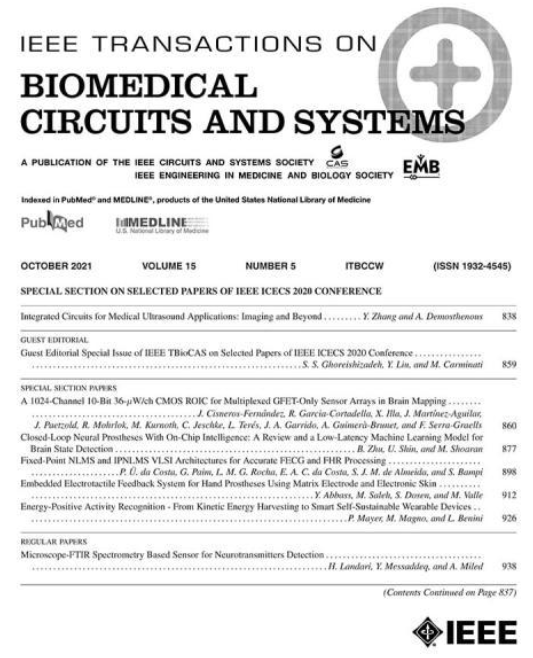基于脉冲射频刺激背根神经节的疼痛控制需求,使用无电池植入式CMOS SoC
IF 4.9
2区 医学
Q2 ENGINEERING, BIOMEDICAL
IEEE Transactions on Biomedical Circuits and Systems
Pub Date : 2010-03-18
DOI:10.1109/ISSCC.2010.5433936
引用次数: 8
摘要
虽然疼痛被许多专业人士视为第五生命体征,但不同程度的疼痛的存在显著影响了许多患者的生活质量,尤其是老年患者。电刺激中枢或外周神经传导通路已在临床上用于达到有效的疼痛缓解[2]。传统的脉冲射频(PRF)疼痛治疗方案使用热凝来通过热永久损伤神经。这种破坏性的方法在神经再生后会产生严重的副作用,比如对疼痛过敏。因此,需要反复手术。此外,传统的植入式系统设计需要电池来运行,通常占整个设备体积的2/3以上。因此,一种非破坏性和无电池的方法使用PRF来控制疼痛是植入式系统的关键。这项工作使用了一种无电池的植入式疼痛控制SoC,它可以有效地减轻疼痛,使用低刺激电压,避免对背根神经节(DRG)组织造成热损伤。一项神经性疼痛的动物研究先前设计了PRF参数,通过外部功能发生器[3]将组织温度控制在≪40°C。这项工作现在提出了该功能在CMOS SoC上的实现。通过观察大鼠腰椎神经DRG局部双极刺激的行为,证明了其有效性。本文章由计算机程序翻译,如有差异,请以英文原文为准。
Pain control on demand based on pulsed radio-frequency stimulation of the dorsal root ganglion using a batteryless implantable CMOS SoC
Although pain is interpreted as the fifth vital sign by many professions, the presence of different degrees of pain significantly affects quality of life for many patients, especially the elderly [1]. Electrical stimulation to the central or peripheral neural conduction paths has been utilized in clinics to achieve effective pain relief [2]. The conventional scheme for pulsed radio-frequency (PRF) pain therapy uses thermal coagulation to permanently damage nerves by heat. This destructive method can cause severe side-effects such as hyper-sensitivity to pain after nerves regenerate. Thus, repeated surgery is needed. Additionally, the conventional design of an implantable system requires a battery for operation, often accounting for over 2/3 of the entire device volume. Therefore, a non-destructive and batteryless method using PRF for pain control is key for implantable systems. This work uses a batteryless implantable pain-control SoC that is effective in pain reduction, using a low stimulation voltage that avoids causing thermal damage to dorsal root ganglion (DRG) tissue. An animal study of neuropathic pain was previously designed with PRF parameters to control tissue temperature at ≪40°C via an external function generator [3]. This work now presents the implementation of this functionality on a CMOS SoC. Its effectiveness is demonstrated by observing the behavior of rats receiving localized bipolar stimulus to the DRG of the lumbar nerve.
求助全文
通过发布文献求助,成功后即可免费获取论文全文。
去求助
来源期刊

IEEE Transactions on Biomedical Circuits and Systems
工程技术-工程:电子与电气
CiteScore
10.00
自引率
13.70%
发文量
174
审稿时长
3 months
期刊介绍:
The IEEE Transactions on Biomedical Circuits and Systems addresses areas at the crossroads of Circuits and Systems and Life Sciences. The main emphasis is on microelectronic issues in a wide range of applications found in life sciences, physical sciences and engineering. The primary goal of the journal is to bridge the unique scientific and technical activities of the Circuits and Systems Society to a wide variety of related areas such as: • Bioelectronics • Implantable and wearable electronics like cochlear and retinal prosthesis, motor control, etc. • Biotechnology sensor circuits, integrated systems, and networks • Micropower imaging technology • BioMEMS • Lab-on-chip Bio-nanotechnology • Organic Semiconductors • Biomedical Engineering • Genomics and Proteomics • Neuromorphic Engineering • Smart sensors • Low power micro- and nanoelectronics • Mixed-mode system-on-chip • Wireless technology • Gene circuits and molecular circuits • System biology • Brain science and engineering: such as neuro-informatics, neural prosthesis, cognitive engineering, brain computer interface • Healthcare: information technology for biomedical, epidemiology, and other related life science applications. General, theoretical, and application-oriented papers in the abovementioned technical areas with a Circuits and Systems perspective are encouraged to publish in TBioCAS. Of special interest are biomedical-oriented papers with a Circuits and Systems angle.
 求助内容:
求助内容: 应助结果提醒方式:
应助结果提醒方式:


